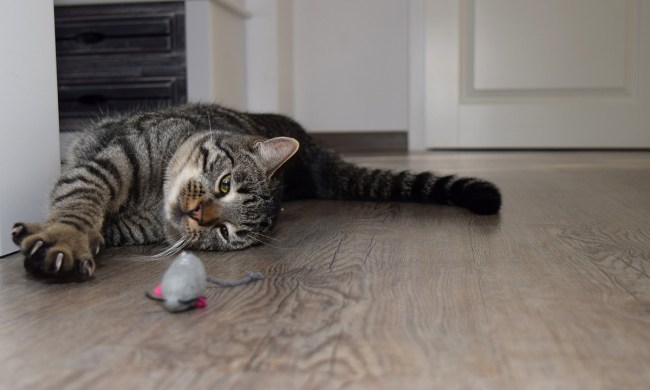Cat parenthood can throw you for a loop, especially if you’re a first-timer. Suddenly, you’re responsible for the health of another breathing creature that doesn’t speak your language and never will. You also may suspect that this breathing creature has it in for you (we’re kidding — we think).
Cats certainly have an independent streak. However, regarding their health, they rely on you to be their eyes and ears — partly because of that aforementioned language barrier. Understanding the signs and symptoms of cat health issues can help you better communicate with their vet. Like humans, cats can have problems with their thyroid, including hyperthyroidism. Here’s what to know about hyperthyroidism in cats, including signs, causes, treatment, and outlook.
What is feline hyperthyroidism?

Hyperthyroidism in cats is a disease caused by a tumor in the thyroid gland. The tumor is typically noncancerous but causes a cat to produce too much of a thyroid hormone called thyroxine.
Backing up, it might help to get a quick biology lesson on the feline body. Cats have two thyroid glands on each side of their necks. They’re located on either side of the windpipe (trachea). A cat’s thyroid gland serves many functions, including metabolic rate, heart rate, and body temperature regulation. Pretty important, right?
However, when a cat’s thyroid overproduces thyroxine, it throws off these crucial functions, primarily metabolic rate and blood pressure.
Cornell Feline Health Center points out that vets and scientists don’t know precisely what causes feline hyperthyroidism. Possible theories include dietary or environmental exposure to compounds that can disrupt the thyroid.
What does a cat with hyperthyroidism look like?

The disease is more common in older cats, but kitties of any age and any breed can develop hyperthyroidism. Therefore, you’ll want to understand the signs of hyperthyroidism in cats so you can flag concerns with your veterinarian. These symptoms mainly include:
- Weight loss
- Increased heart rate
- Significant increase in appetite and thirst
- Significant GI discomfort (vomiting and diarrhea)
- Peeing more
- Rapid or other breathing difficulties
- Restless behavior
- Aggression
- Lump on the neck near the trachea and voice box (where the thyroid is)
- Thicker nails
How is hyperthyroidism in cats treated?

The good news is that hyperthyroidism in cats is rarely caused by cancerous tumors. However, the disease disrupts important functions and requires long-term care. Here’s what to know about diagnosis and treatment and the outlook for feline hyperthyroidism.
Diagnosis of hyperthyroidism
First — and significantly — the signs of hyperthyroidism in cats can overlap with other conditions. Your vet will need to diagnose hyperthyroidism first.
Diagnosing hyperthyroidism in cats is relatively simple (at least for the vet) because it generally only requires a simple blood test. The vet will look at your cat’s levels of thyroxine. If they’re high, your vet will diagnose your cat with hyperthyroidism. Sometimes, a cat’s levels will be high but normal. In these cases, your veterinarian might order a second round of bloodwork in a few weeks to double-check levels.
If your cat has hyperthyroidism, the vet will probably order some more tests to determine the best course of treatment, including:
- More bloodwork
- Urine sample
- Chest X-rays
- Echocardiogram (since hyperthyroidism can affect the heart)
- Blood pressure
- Thyroid scintigraphy (radioactive scan)
Treatment of feline hyperthyroidism
Hyperthyroidism is usually treatable — and may even be curable. Your options include:
- Radioiodine therapy. Also known as Radioactive Iodine Treatment or I131 treatment, this therapy can cure hyperthyroidism. I131 treatment combats abnormal thyroid tissue while keeping other organs safe. Your cat will need to stay in the hospital for a week or two for monitoring.
- Surgery. This treatment can also cure hyperthyroidism and requires hospitalization. There’s a chance your cat can develop hypothyroidism (underproduction of hormones), so your kitty’s care team will keep a close eye on them long term.
- Methimazole. This lifelong medication doesn’t cure the disease but can help manage the condition. It’s generally given orally.
The prognosis is usually good, though there’s a chance of recurrence in cats that took curative approaches.
Final thoughts on hyperthyroidism in cats

Cats have two thyroid glands that help them with numerous bodily functions, including metabolism and heart rate. When these glands produce too much of a hormone called thyroxine, a cat can develop hyperthyroidism. Rarely is hyperthyroidism in cats triggered by a cancerous tumor. Even when the tumor isn’t cancerous, your cat will require care because of the number of vital functions and organs potentially effected by hyperthyroidism.
Vets usually diagnose hyperthyroidism in cats with a blood test. Treatments include curative surgery and radioiodine therapy or lifelong medications. Symptoms include increased appetite, stomach issues, and hyperactivity. Keep an eye on your cat, and let your vet know about any concerns so you can work together on finding the best treatment.




